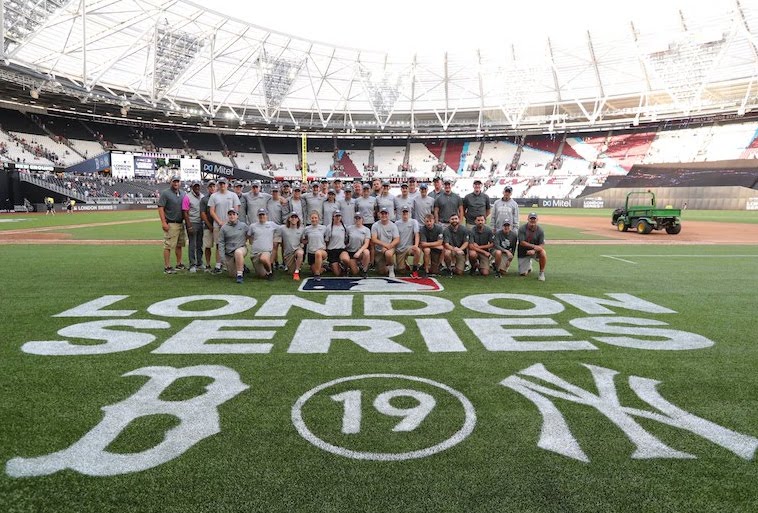Photo by Alex Trautwig/MLB Photos
We caught up with Murray Cook, president of BrightView Sports Turf, right after the historic, first-ever Major League Baseball (MLB) series in Europe, a 2-game set in late June between the Yankees and Red Sox. BrightView is the Official Field Consultant to MLB, providing field design and construction for games outside the league’s 30 existing ballparks.
ST: What challenges at London Stadium did you encounter compared to other international fields you’ve set up?
Cook: We started looking around the UK in 2013 for options; we looked at famous Wembley Stadium, The Oval field, and several other sites throughout the United Kingdom, all of which presented challenges. Even with our chosen Queen Elizabeth Olympic Park’s London Stadium we were going to be in a tight situation with the dimensions. After numerous discussions with MLB, the Player’s Association, and Populous (architectural and design company), we moved forward with London Stadium.
We had ONLY 21 days to build the entire ballpark and field of play for the first-ever MLB games in Europe. Furthermore, we would only have 5 days to bump-out of the venue so they could prepare for the West Ham football season. We would not be able to drill or sink holes into the ground due to the armor-decking layer, the track and field surface, and the West Ham Desso pitch (GrassMaster) so everything from foul poles, fencing, dugouts, gates, etc., had to be secured by using concrete ballasting. As part of the build we removed tiles and added drainage lines.
We wanted to go natural grass and did not make the change to synthetic until earlier this year, mainly because of the risk of the weather and the extremely short time table with absolutely no time for natural grass to have any issues related to the harvesting and/or weather.
In hindsight it was the right decision because it rained the first 16 days of 18 during construction. We have stored all the infield clay, synthetic turf and infill to be used again for next year’s games between the Cubs and Cardinals.
MLB was pushing for a deal at London Stadium in 2017 but it fell apart due to timing and construction of the venue. So in 2017 we really began detailing the plans as to how we might be able to pull this off. Since the stadium surface has varied grades we needed to level the entire surface to build the baseball field.
On a side note, there was an exhibition game played between the Red Sox and Mets at The Oval in 1993. It’s a cricket ground. I remember Harry Brind, the head groundsman, and his assistant Bill Gordon helping me lay out the clay cut outs. It rained every day until we had no more time to build the pits, then the final day we played.
Our contractors, vendors and Brightview Sportsturf team deserve all the credit pulling this one off. The Hewitt’s sportsturf contractors were outstanding, along with design team Populous, the project management firm G and T, as well as MLB Ops and MLBPA staff that stuck with us from the beginning to the end.
ST: When you assess a new venue/field for MLB, what are you looking for most specifically?
Cook: First we look for the best dimensions and orientation. Timing of the event and what the venue will allow us to do is a longer discussion, along with having proper resources to pull off the transition. Some countries are more fortunate than others.
ST: Was there time for fun in London?
Cook: Not on this event! We worked 30+ days in a row to pull this one off, which takes a toll on the mind and body. I was able to get out and see some of the country though during earlier site visits.
ST: What’s the next MLB assignment for you?
Cook: Williamsport again for the Little League Classic, and there are a couple other things MLB is working on.
Materials
- 141,000 sq. ft. of FieldTurf Vertex 360
- 4400 tons of aggravate to level the pitch and track
- 340 tons of DuraEdge clay
- 12 tons of Turface soil conditioner
- 700 wall pads from Covermaster
- 53,000 sq. ft. of chicken wire to cover the lights
- 2 60-foot foul poles
- Batting tunnels and all the BP equipment from Beacon Athletics and C&H Baseball


